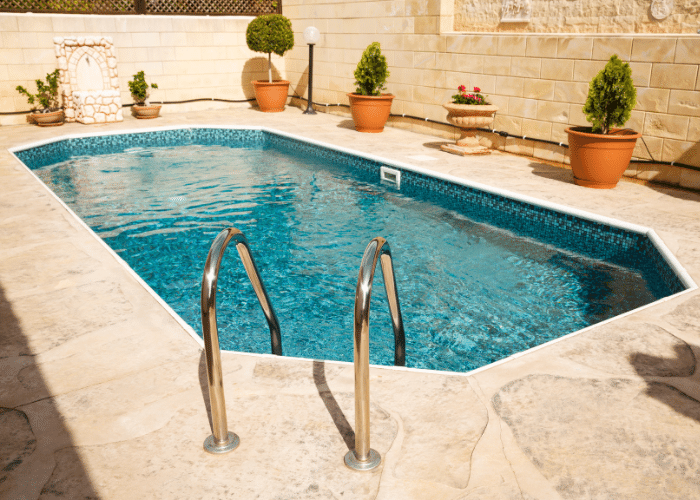If asked to describe the environmental impact of swimming pools your first response is unlikely to be related to their ‘eco-friendliness’. In fact, most swimming pools are anything but ‘green’. They often use considerable amounts of energy to keep the water heated, and chemicals such as chlorine which are used to keep them clean can be sources of pollution. But what if there was a way to have a swimming pool that was both eco-friendly and fun? It may sound like a pipe dream, but it’s actually possible! In this article, we’ll look in detail at exactly what is meant by the terms ‘eco-friendly’ and ‘natural swimming pool’, as well as exactly how to create a sustainable swimming pool.
With more than 25 years experience designing, installing and maintaining all types of swimming pools throughout Sussex, Surrey and Kent we have the knowledge and expertise to help you create the environmentally friendly swimming pool of your dreams. To find out more about any of our services call us today on 01444236578, or send your enquiry to enquiries@hydrocare.co.uk and we’ll be in touch.
What is an eco friendly pool?
The term eco friendly pool may refer to any swimming pool that has been designed, constructed and maintained with the environment in mind. This may include the use of sustainably sourced natural materials in its construction, a reduction (or absence) in the amount of energy required for heating, as well as the use of natural cleaning products in its maintenance.
It wasn’t until the late 1990s that eco friendly swimming pools began to gain popularity. This was largely due to the launch of the first eco pool filter, which used activated carbon to clean the water. Since then, the popularity of eco friendly pools has continued to grow, as more and more people become aware of the benefits of swimming in natural water.
Some of the key benefits of eco friendly pools include:
- They are healthier for swimmers, as they don’t contain chlorine or other harsh chemicals.
- They can often be cheaper to maintain than traditional swimming pools.
- They can be installed in any size or shape, making them perfect for any garden or outdoor space.
Is there a difference between eco friendly and natural swimming pools?
‘Eco friendly pool’ is a broad term used to describe swimming pools that differ from a conventional swimming pool in their approach to sustainability and environmental friendliness.
Pools which utilise high performance filtration management systems can be considered ‘eco friendly’. Some examples of this include:
Ozone filtration
Ozone gas (O3) generators are installed within the existing circulation system. As water passes through the generator (or ozonator) it is sterilised before being circulated back into the swimming pool. Ozone gas is highly effective in the eradication of microorganisms including bacteria, fungi, and moulds, and has virtually no environmental impact.
Salt electrolysis
Through the process of electrolysis, salt cells, or salt generators split sodium chloride (NaCI) atoms to create chlorine (CI). Although this treatment process does still rely on the use of chlorine, levels are far lower as the supply is constantly replenished. The process also has the added benefit of eliminating chloramines – the compound responsible for the ‘chlorine smell’, which can also cause respiratory problems when found in high levels.
Ultraviolet radiation
Using UV lamps, ultraviolet light efficiently attacks the harmful pathogens and bacteria found in swimming pools, eliminating their ability to reproduce, before killing them. Like ozone filtration and salt electrolysis, ultraviolet radiation is so effective that it is commonly used in the purification of drinking water.
Natural pools
A natural swimming pond (or bio pool), utilises what is known as a ‘regeneration zone’ for sanitation. Completely chemical free, these pools or ponds rely on aquatic plants to filter and oxygenate the water. This ‘in-built’ ecosystem of aquatic life provides low maintenance, natural purification creating a much healthier swimming environment in comparison to a traditional pool, or chlorinated pool.
How do you make a swimming pool sustainable?
Building an eco friendly swimming pool
Traditionally swimming pools have been constructed using materials like concrete and gunite, which, although tough and long lasting, are less than eco friendly in their creation. HeatForm pools are an environmentally friendly alternative – they’re made using recycled materials previously destined for landfill – greatly reducing energy consumption and the overall carbon footprint of the pool.
If you want to see an eco friendly swimming pool being built, check out our Youtube channel where we built an eco friendly pool in just two weeks.
Use a pool cover
Swimming pools lose the majority of their heat through evaporation and convection, which can end up costing considerable amounts of money throughout the course of a year. A pool cover could help to reduce those costs – in fact using a pool cover could actually create savings of more than £2000 annually.
Upgrade equipment
Upgrading your pool equipment can also help to reduce your energy consumption, making your pool more eco-friendly. One way to do this is by using eco-friendly pumps which are more efficient and designed to use less energy. Solar panels can also be used to power pumps, filters, and other devices further reducing your energy consumption while saving you money on your electric bill.
Get a quote for your eco friendly pool
Give us a call today on 01444236578 to discuss your natural pool. Our team are experts in designing, installing and maintaining swimming pools of all shapes and sizes across Sussex and Surrey.



